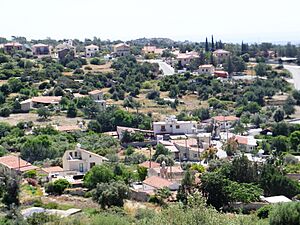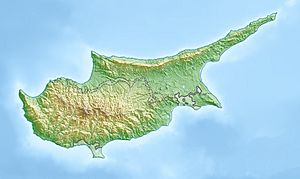Sotira, Limassol facts for kids
Quick facts for kids
Sotira
Σωτήρα
|
|
|---|---|
|
village
|
|
 |
|
| Country | |
| District | Limassol District |
| Population
(2001)
|
|
| • Total | 83 |
| Time zone | UTC+2 (EET) |
| • Summer (DST) | UTC+3 (EEST) |
Sotira (Greek: Σωτήρα) is a small village in Cyprus. It is located partly in the Limassol District and partly in the British Overseas Territory of Akrotiri and Dhekelia. Sotira is found west of Limassol, close to Episkopi.
Contents
Ancient Sotira Culture
The Sotira Culture was a very old way of life in Cyprus. It existed during the Ceramic Neolithic Period, from about 5000 to 4000 BCE. This culture appeared after the older Khirokitia Culture sites were no longer used.
New Settlers and Pottery
New people arrived in Cyprus around 5250 BCE. They brought with them new skills, like making pottery. The Sotira Culture started a couple of centuries after these new pottery-making skills appeared on the island.
Life at Sotira-Teppes
The Sotira Culture is named after a special ancient site called Sotira-Teppes. Here, archaeologists found many house foundations built close together. These houses were made with light materials.
House Designs
The houses at Sotira-Teppes had different shapes. Some were round, while others were rectangular with rounded corners. The upper parts of the walls were likely made from mud bricks. The roofs of the rectangular houses were probably flat.
Discoveries Inside Homes
When digging deeper, experts found well-preserved hearths (fireplaces) and post-holes (where wooden posts stood). They also found many tools made from flint, stone, and bone. People also used bowls and jugs with special combed patterns.
Where Ancient Sites Were Found
Most Ceramic Neolithic sites, like Sotira-Teppes, were built near the coast. They were often on high ground, which made them easier to defend. Another important site is called Ayios Epiktitos-Vyrsi.
Culture Spread
These ancient sites are mostly found in the eastern part of Cyprus. This shows that the new settlers did not reach the western parts of the island or the long 'finger' of land called the Karpass Peninsula.
Changes Over Time
As the Sotira Culture continued, there were some differences between regions. People also found better ways to make things. There were about thirty villages known from this culture.
Why Sites Were Left Behind
Only a few of these villages were still lived in during the next period. Just like the Khirokitia Culture before it, we don't fully know why most Sotira sites were abandoned.


